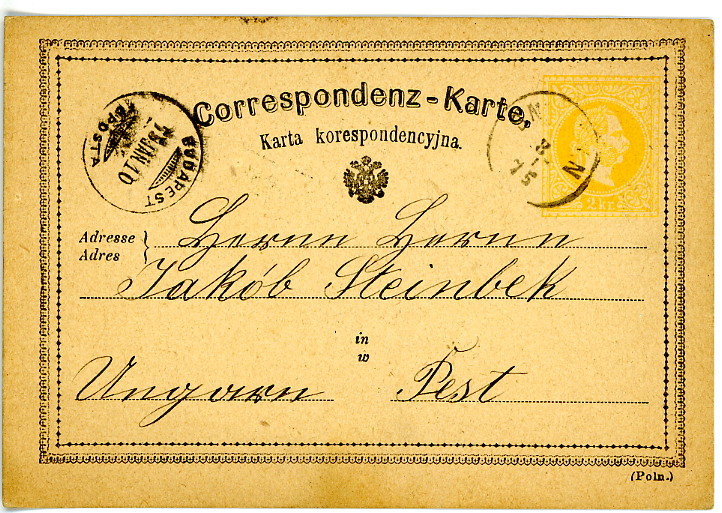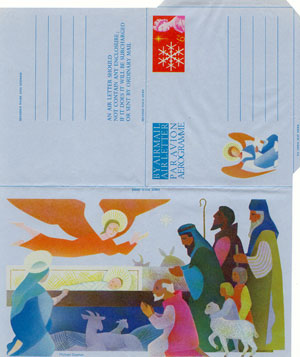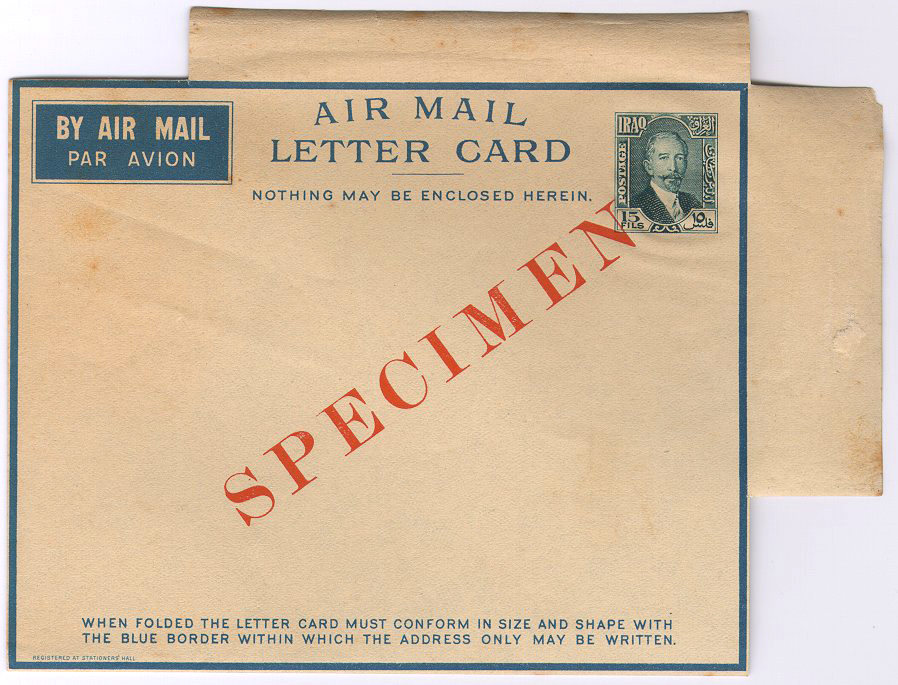|
Lettercard
In philately, a lettercard or letter card is a postal stationery item consisting of a folded card with a prepaid imprinted stamp. That it is folded over gives the writer twice as much room for the message compared with a postal card. The message is written on the inside and the card is then folded and sealed around the edges. The recipient tears off and discards the perforated selvages to open the card. The lettercard was first conceived by a Hungarian named Akin KarolyVan Gelder, Peter J.; ''The Collectors' Guide to Postal Stationery'', A Squirrel Publication (1997) and introduced in Belgium in 1882. Private issues were used in Great Britain in 1887.Mackay, James. ''Philatelic Terms Illustrated''. 4th edition. London: Stanley Gibbons, 2003, p.78. . The first official British letter card was issued in 1892. In Newfoundland ''reply lettercards'' were introduced in 1912 which included a small reply card. Letter cards were issued in a variety of card stock and colour. As with a ... [...More Info...] [...Related Items...] OR: [Wikipedia] [Google] [Baidu] |
Postal Stationery
A piece of postal stationery is a stationery item, such as a stamped envelope, letter sheet, postal card, lettercard, aerogram or wrapper, with an imprinted stamp or inscription indicating that a specific rate of postage or related service has been prepaid. It does ''not'', however, include any postcard without a pre-printed stamp, and it is different from freepost for preprinted cards issued by businesses. In general, postal stationery is handled similarly to postage stamps; sold from post offices either at the face value of the printed postage or, more likely, with a surcharge to cover the additional cost of the stationery. It can take the form of an official mail issue produced only for the use of government departments.Horning, Otto; ''The Illustrated Encyclopedia of Stamp Collecting'' (1970). History Postal stationery has been in use since at least 1608 with folded letters bearing the coat of arms Venice. Other early examples include British newspaper stamps th ... [...More Info...] [...Related Items...] OR: [Wikipedia] [Google] [Baidu] |
Adhesive Postage Stamp
A postage stamp is a small piece of paper issued by a post office, postal administration, or other authorized vendors to customers who pay postage (the cost involved in moving, insuring, or registering mail), who then affix the stamp to the face or address-side of any item of mail—an envelope or other postal cover (e.g., packet, box, mailing cylinder)—that they wish to send. The item is then processed by the postal system, where a postmark or cancellation mark—in modern usage indicating date and point of origin of mailing—is applied to the stamp and its left and right sides to prevent its reuse. The item is then delivered to its addressee. Always featuring the name of the issuing nation (with the exception of the United Kingdom), a denomination of its value, and often an illustration of persons, events, institutions, or natural realities that symbolize the nation's traditions and values, every stamp is printed on a piece of usually rectangular, but sometimes triangular ... [...More Info...] [...Related Items...] OR: [Wikipedia] [Google] [Baidu] |
GB 1892 1d Uprated Lettercard
GB, or Gb may refer to: Places * United Kingdom (ISO 3166-1 code), a sovereign country situated off the north-western coast of continental Europe ** Great Britain, an island situated off the north-western coast of continental Europe ** Kingdom of Great Britain (1707–1800), a predecessor country of the United Kingdom * Gilgit-Baltistan, a region in northern Pakistan * Guinea-Bissau, a sovereign state in West Africa * Green Bay, Wisconsin, United States * Great Barrington, Massachusetts, United States Businesses and organisations * GB Airways, a British airline * Gardner Bender, a manufacturer of professional electrician's tools and supplies * Girls' Brigade, a Christian organization for girls * Grande Bibliothèque, a large public library in Montreal * University of Wisconsin–Green Bay, an American university * ABX Air (IATA airline designator GB), a cargo airline * GB Glace, a Swedish ice cream company * Griesedieck Brothers beer, an American beer brand * GB Supermarke ... [...More Info...] [...Related Items...] OR: [Wikipedia] [Google] [Baidu] |
Air Mail Letter Card 1943
The atmosphere of Earth is the layer of gases, known collectively as air, retained by Earth's gravity that surrounds the planet and forms its planetary atmosphere. The atmosphere of Earth protects life on Earth by creating pressure allowing for liquid water to exist on the Earth's surface, absorbing ultraviolet solar radiation, warming the surface through heat retention (greenhouse effect), and reducing temperature extremes between day and night (the diurnal temperature variation). By mole fraction (i.e., by number of molecules), dry air contains 78.08% nitrogen, 20.95% oxygen, 0.93% argon, 0.04% carbon dioxide, and small amounts of other gases. Air also contains a variable amount of water vapor, on average around 1% at sea level, and 0.4% over the entire atmosphere. Air composition, temperature, and atmospheric pressure vary with altitude. Within the atmosphere, air suitable for use in photosynthesis by terrestrial plants and breathing of terrestrial animals is found only in ... [...More Info...] [...Related Items...] OR: [Wikipedia] [Google] [Baidu] |
Philately
Philately (; ) is the study of postage stamps and postal history. It also refers to the collection and appreciation of stamps and other philatelic products. Philately involves more than just stamp collecting or the study of postage; it is possible to be a philatelist without owning any stamps. For instance, the stamps being studied may be very rare or reside only in museums. Etymology The word "philately" is the English transliteration of the French "", coined by Georges Herpin in 1864. Herpin stated that stamps had been collected and studied for the previous six or seven years and a better name was required for the new hobby than ''timbromanie'' (roughly "stamp quest"), which was disliked.Williams, L.N. & M. ''Fundamentals of Philately''. State College: The American Philatelic Society, 1971, p.20. The alternative terms "timbromania", "timbrophily", and "timbrology" gradually fell out of use as ''philately'' gained acceptance during the 1860s. Herpin took the Greek root word ... [...More Info...] [...Related Items...] OR: [Wikipedia] [Google] [Baidu] |
Imprinted Stamp
In philately, an imprinted stamp is a stamp printed onto a piece of postal stationery such as a stamped envelope, postal card, letter sheet, letter card, aerogram or wrapper.Carlton, R. Scott. ''The International Encyclopedic Dictionary of Philately''. Iola WI: Krause Publications, 1997, p.117. . The printing may be flat upon the surface of the paper, or embossed with a raised relief.Van Gelder, Peter J.; ''The Collectors' Guide to Postal Stationery'', A Squirrel Publication, Shrewsbury, UK (1997) An imprinted stamp is also known as unadhesive stamp or indicium. The cost of the item of stationery includes the manufacture of the item and the charge for postal service. The design of imprinted stamps often bears a close resemblance to normal adhesive stamps of the same country and era. It may be a definitive or commemorative stamp. Collecting In the early days of philately, it was common to cut the imprinted stamp from the rest of the item and retain only the stamp. This ... [...More Info...] [...Related Items...] OR: [Wikipedia] [Google] [Baidu] |
Postal Card
Postal cards are postal stationery with an imprinted stamp or indicium signifying the prepayment of postage. They are sold by postal authorities. On January 26, 1869, Dr. Emanuel Herrmann of Austria described the advantages of a ''Correspondenz Karte''. By October 1, 1869 the world's first postal card was produced by Austria-Hungary.Van Gelder, Peter J.; ''The Collectors' Guide to Postal Stationery'', A Squirrel Publication (1997) They caught on quickly. By the end of 1870, Great Britain, Finland, Switzerland and Württemberg joined the countries issuing postal cards. In the United States, they were first produced in 1873.Bussey, Lewis E., Ed.; ''United States Postal Card Catalog'', United Postal Stationery Society, 2010, 248 pages. A complete and authoritative look at U.S. postal cards. Some of the forms taken by postal cards include the regular single card which may be commemorative or definitive, attached message-reply cards, airmail postal cards, and official postal ... [...More Info...] [...Related Items...] OR: [Wikipedia] [Google] [Baidu] |
Aerogram
An aerogram, aerogramme, aérogramme, air letter or airletter is a thin lightweight piece of foldable and gummed paper for writing a letter for transit via airmail, in which the letter and envelope are one and the same. Most postal administrations forbid enclosures in these light letters, which are usually sent abroad at a preferential rate. Printed warnings existed to say that an enclosure would cause the mail to go at the higher letter rate. The use of the term ''aerogramme'' was officially endorsed at the 1952 Universal Postal Union Postal Union Congress in Brussels."The Evolution of the Postal Service in the Era of the UPU" by Jamie Gough in ''The London Philatelist'', Vol.114, No. 1331, December 2005, pp.362-363. Thereafter, the term ''air letter'' quickly faded from use. Most aerograms have an imprinted stamp indicating the prepayment of postage. As such, this meets the definition of being postal stationery. However, some countries such as New Zealand, Zimbabwe and Irel ... [...More Info...] [...Related Items...] OR: [Wikipedia] [Google] [Baidu] |
Letter Sheet
In philatelic terminology a letter sheet, often written lettersheet, is a sheet of paper that can be folded, usually sealed (most often with sealing wax in the 18th and 19th centuries), and mailed without the use of an envelope, or it can also be a similar item of postal stationery issued by a postal authority. Letter sheets derive from the form in which written correspondence was made up before the mid-19th century — letters were written on one or more sheets of paper that were folded and sealed in such a way that the address could be written on the outside. The term lettersheet has been used to describe the unstamped folded sheet letters used before envelopes became popular. Recent academic research and conservation initiatives have termed such folded and sealed letters as "letterpackets”; however, only a relatively small number of early examples, such as the Brienne Collection (1689–1706) at The Hague, are known to exist. Envelopes were not used much before the sec ... [...More Info...] [...Related Items...] OR: [Wikipedia] [Google] [Baidu] |
Letter Sheet
In philatelic terminology a letter sheet, often written lettersheet, is a sheet of paper that can be folded, usually sealed (most often with sealing wax in the 18th and 19th centuries), and mailed without the use of an envelope, or it can also be a similar item of postal stationery issued by a postal authority. Letter sheets derive from the form in which written correspondence was made up before the mid-19th century — letters were written on one or more sheets of paper that were folded and sealed in such a way that the address could be written on the outside. The term lettersheet has been used to describe the unstamped folded sheet letters used before envelopes became popular. Recent academic research and conservation initiatives have termed such folded and sealed letters as "letterpackets”; however, only a relatively small number of early examples, such as the Brienne Collection (1689–1706) at The Hague, are known to exist. Envelopes were not used much before the sec ... [...More Info...] [...Related Items...] OR: [Wikipedia] [Google] [Baidu] |
Aerogram
An aerogram, aerogramme, aérogramme, air letter or airletter is a thin lightweight piece of foldable and gummed paper for writing a letter for transit via airmail, in which the letter and envelope are one and the same. Most postal administrations forbid enclosures in these light letters, which are usually sent abroad at a preferential rate. Printed warnings existed to say that an enclosure would cause the mail to go at the higher letter rate. The use of the term ''aerogramme'' was officially endorsed at the 1952 Universal Postal Union Postal Union Congress in Brussels."The Evolution of the Postal Service in the Era of the UPU" by Jamie Gough in ''The London Philatelist'', Vol.114, No. 1331, December 2005, pp.362-363. Thereafter, the term ''air letter'' quickly faded from use. Most aerograms have an imprinted stamp indicating the prepayment of postage. As such, this meets the definition of being postal stationery. However, some countries such as New Zealand, Zimbabwe and Irel ... [...More Info...] [...Related Items...] OR: [Wikipedia] [Google] [Baidu] |
Postcard
A postcard or post card is a piece of thick paper or thin cardboard, typically rectangular, intended for writing and mailing without an envelope. Non-rectangular shapes may also be used but are rare. There are novelty exceptions, such as wooden postcards, copper postcards sold in the Copper Country of the U.S. state of Michigan, and coconut "postcards" from tropical islands. In some places, one can send a postcard for a lower fee than a letter. Stamp collectors distinguish between postcards (which require a postage stamp) and postal cards (which have the postage pre-printed on them). While a postcard is usually printed and sold by a private company, individual or organization, a postal card is issued by the relevant postal authority (often with pre-printed postage). Production of postcards blossomed in the late 19th and early 20th centuries. As an easy and quick way for individuals to communicate, they became extremely popular. The study and collecting of postcards is ter ... [...More Info...] [...Related Items...] OR: [Wikipedia] [Google] [Baidu] |











